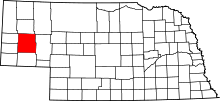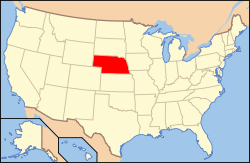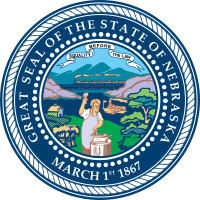Morrill County, Nebraska
| Morrill County, Nebraska | |
|---|---|
|
Morrill County Courthouse in Bridgeport | |
 Location in the U.S. state of Nebraska | |
 Nebraska's location in the U.S. | |
| Founded | 1908 |
| Named for | Charles Henry Morrill |
| Seat | Bridgeport |
| Largest city | Bridgeport |
| Area | |
| • Total | 1,430 sq mi (3,704 km2) |
| • Land | 1,424 sq mi (3,688 km2) |
| • Water | 6.0 sq mi (16 km2), 0.4% |
| Population | |
| • (2010) | 5,042 |
| • Density | 3.5/sq mi (1.4/km2) |
| Congressional district | 3rd |
| Time zone | Mountain: UTC−7/−6 |
| Website |
www |
Morrill County is a county located in the U.S. state of Nebraska. As of the 2010 census, the population was 5,042.[1] Its county seat is Bridgeport.[2]
History
The Battle of Mud Springs and the Battle of Rush Creek between the U.S. army and the Cheyenne, Lakota Sioux, and Arapaho Indians took place in 1865 within what would become Morrill county.
Morrill County was formed in 1908 "carved out of Cheyenne County".[3] It was named after Charles Henry Morrill, a president of the Lincoln Land Company.[4]
In the Nebraska license plate system, Morrill County is represented by the prefix 64 (it had the sixty-fourth-largest number of vehicles registered in the county when the license plate system was established in 1922).
Geography
According to the U.S. Census Bureau, the county has a total area of 1,430 square miles (3,700 km2), of which 1,424 square miles (3,690 km2) is land and 6.0 square miles (16 km2) (0.4%) is water.[5]
The North Platte River runs through Morrill County, from northwest to southeast. It passes through or near Bayard, Bridgeport, and Broadwater.[6]
Two U.S. highways run through Morrill County. U.S. Highway 385 runs generally north-south through the county, passing through Bridgeport and Angora. U.S. Highway 26 runs roughly northwest-southeast, following the North Platte for the most part. Nebraska Highway 92 runs contiguous with U.S. 26 for most of its length through the county, though following the opposite bank of the North Platte between Bridgeport and Broadwater. Nebraska Highway 88 enters the county in its southwest quarter, runs eastward until south of Bridgeport, the turns north and ends at Bridgeport.[6]
Morrill County borders six other Nebraska counties. Scotts Bluff and Banner Counties border it on its west; Cheyenne County lies to the south; Garden County is to the east; and most of the northern border is with Box Butte County, though about a mile of the northern border at the county's northeast corner is with Sheridan County.[6]
Chimney Rock, a rock formation 325 feet (99 m) tall with a 120-foot (37 m) spire, lies about four miles (six kilometers) south of Bayard, in western Morrill County. The rock was a prominent landmark on the Oregon Trail, and has become a symbol of Nebraska, appearing on the state's license plates and on its commemorative quarter.[7][8][9]
Politics and government
Morrill County lies within Nebraska's Third Congressional District.[10] As of 2017, it was represented in the U.S. House of Representatives by Adrian Smith, a member of the Republican Party.[11] As of 2017, the county was part of the state's 47th legislative district,[12] and was represented in the Nebraska Legislature by Steve Erdman; Erdman is a member of the Republican Party, though the Legislature is officially nonpartisan.[13]
As of late 2016, there were 3314 registered voters in Morrill County. Of these, 2175, or 65.6%, were Republicans; 591, or 17.8%, were Democrats; 522, or 15.8%, registered no political party; and 26, or 0.8%, were Libertarians.[14]
Demographics
| Historical population | |||
|---|---|---|---|
| Census | Pop. | %± | |
| 1910 | 4,584 | — | |
| 1920 | 9,151 | 99.6% | |
| 1930 | 9,950 | 8.7% | |
| 1940 | 9,436 | −5.2% | |
| 1950 | 8,263 | −12.4% | |
| 1960 | 7,057 | −14.6% | |
| 1970 | 5,813 | −17.6% | |
| 1980 | 6,085 | 4.7% | |
| 1990 | 5,423 | −10.9% | |
| 2000 | 5,440 | 0.3% | |
| 2010 | 5,042 | −7.3% | |
| Est. 2016 | 4,787 | [15] | −5.1% |
| U.S. Decennial Census[16] 1790-1960[17] 1900-1990[18] 1990-2000[19] 2010-2013[1] | |||
As of the census[20] of 2000, there were 5,440 people, 2,138 households, and 1,494 families residing in the county. The population density was 4 people per square mile (1/km²). There were 2,460 housing units at an average density of 2 per square mile (1/km²). The racial makeup of the county was 93.68% White, 0.07% Black or African American, 0.72% Native American, 0.22% Asian, 4.12% from other races, and 1.19% from two or more races. 10.09% of the population were Hispanic or Latino of any race. 40.5% were of German, 9.2% English, 7.3% Irish and 6.7% American ancestry according to Census 2000.
There were 2,138 households out of which 32.10% had children under the age of 18 living with them, 59.50% were married couples living together, 6.50% had a female householder with no husband present, and 30.10% were non-families. 26.90% of all households were made up of individuals and 13.00% had someone living alone who was 65 years of age or older. The average household size was 2.49 and the average family size was 3.03.
In the county, the population was spread out with 27.20% under the age of 18, 7.20% from 18 to 24, 24.40% from 25 to 44, 24.20% from 45 to 64, and 17.00% who were 65 years of age or older. The median age was 40 years. For every 100 females there were 97.90 males. For every 100 females age 18 and over, there were 95.60 males.
The median income for a household in the county was $30,235, and the median income for a family was $36,673. Males had a median income of $27,107 versus $19,271 for females. The per capita income for the county was $14,725. About 10.00% of families and 14.70% of the population were below the poverty line, including 20.00% of those under age 18 and 10.30% of those age 65 or over.
Communities
- Angora
- Atkins
- Bayard
- Bonner
- Bridgeport (county seat)
- Broadwater
- Lynn
- Moomaw Corner
- Northport
- Redington
- Vance
See also
References
- 1 2 "State & County QuickFacts". United States Census Bureau. Archived from the original on July 15, 2011. Retrieved September 21, 2013.
- ↑ "Find a County". National Association of Counties. Retrieved June 7, 2011.
- ↑ Supreme Court Sherlock v Gillis
- ↑ "Archived copy". Archived from the original on 2011-07-16. Retrieved 2010-03-25. Retrieved on March 15, 2008.
- ↑ "2010 Census Gazetteer Files". United States Census Bureau. August 22, 2012. Archived from the original on November 13, 2013. Retrieved December 9, 2014.
- 1 2 3 Nebraska State Highway Map. Nebraska Department of Transportation. Retrieved December 8, 2017.
- ↑ Bauer, Scott. "Nebraska's Popular Chimney Rock Eroding". Washington Post. July 15, 2006. Retrieved December 8, 2017.
- ↑ "Chimney Rock site of Sunday Afternoon at the Rock series". Scottsbluff Star-Herald. February 7, 2017. Retrieved December 8, 2017.
- ↑ "Chimney Rock National Historic Site". City of Bayard. Retrieved December 8, 2017.
- ↑ "Congress—Maps Clearinghouse". Nebraska Legislature. Retrieved December 8, 2017.
- ↑ "Adrian Smith". House Republicans. Retrieved December 8, 2017.
- ↑ "Legislature—Maps Clearinghouse. Nebraska Legislature. Retrieved December 8, 2017.
- ↑ 2016–17 Nebraska Blue Book, p. 314 for Erdman, p. 276 for nonpartisan Legislature. Retrieved December 8, 2017.
- ↑ "Count of Registrants Eligible to Vote". Nebraska Secretary of State. Retrieved December 8, 2017.
- ↑ "Population and Housing Unit Estimates". Retrieved June 9, 2017.
- ↑ "U.S. Decennial Census". United States Census Bureau. Retrieved December 9, 2014.
- ↑ "Historical Census Browser". University of Virginia Library. Retrieved December 9, 2014.
- ↑ "Population of Counties by Decennial Census: 1900 to 1990". United States Census Bureau. Retrieved December 9, 2014.
- ↑ "Census 2000 PHC-T-4. Ranking Tables for Counties: 1990 and 2000" (PDF). United States Census Bureau. Retrieved December 9, 2014.
- ↑ "American FactFinder". United States Census Bureau. Retrieved 2008-01-31.
